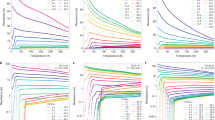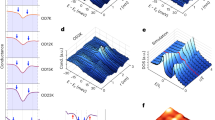Abstract
To decipher the mechanism of high-temperature superconductivity, it is important to know how the superconducting pairing emerges from the unusual normal states of cuprate superconductors1,2,3,4, including the pseudogap5,6, strange metal7,8 and anomalous Fermi liquid9 phases. A long-standing issue is how the superconducting pairing is formed and condensed in the strange metal phase, because this is where the superconducting transition temperature is highest. Here, we use state-of-the-art high-pressure measurements to report the experimental observation of a pressure-induced crossover from two- to three-dimensional (2D to 3D) superconducting states in optimally doped Bi2Sr2CaCu2O8 + δ bulk superconductor. By analysing the temperature dependence of the resistance, we find that the 2D superconducting transition exhibits a Berezinskii–Kosterlitz–Thouless-like behaviour10. The emergence of this 2D superconducting transition provides direct evidence that the strange metal state is predominantly 2D-like. This is important for a thorough understanding of the phase diagram of cuprate superconductors.
This is a preview of subscription content, access via your institution
Access options
Access Nature and 54 other Nature Portfolio journals
Get Nature+, our best-value online-access subscription
$29.99 / 30 days
cancel any time
Subscribe to this journal
Receive 12 print issues and online access
$209.00 per year
only $17.42 per issue
Buy this article
- Purchase on Springer Link
- Instant access to full article PDF
Prices may be subject to local taxes which are calculated during checkout




Similar content being viewed by others
References
Keimer, B., Kivelson, S. A., Norman, M. R., Uchida, S. & Zaanen, J. From quantum matter to high-temperature superconductivity in copper oxides. Nature 518, 179–186 (2015).
Zaanen, J. Superconducting electrons go missing. Nature 536, 282–283 (2016).
Norman, M. R. & Pépin, C. The electronic nature of high temperature cuprate superconductors. Rep. Prog. Phys. 66, 1547–1610 (2003).
Coleman, P. & Schofield, A. J. Quantum criticality. Nature 433, 226–229 (2005).
Vishik, I. M. Photoemission perspective on pseudogap, superconducting fluctuations and charge order in cuprates: a review of recent progress. Rep. Prog. Phys. 81, 062501 (2018).
Ding, H. et al. Spectroscopic evidence for a pseudopgap in the normal state of underdoped high-T c superconductors. Nature 382, 51–54 (1996).
Zaanen, J. Planckian dissipation, minimal viscosity and the transport in cuprate strange metals. SciPost Phys. 6, 061 (2019).
Greene, R. L., Mandal, P. R., Poniatowski, N. R. & Sarkar, T. The strange metal state of the electron-doped cuprates. Preprint at https://arxiv.org/abs/1905.04998 (2019).
Bozovic, I., He, X., Wu, J. & Bollinger, A. T. Dependence of the critical temperature in overdoped copper oxides on superfluid density. Nature 536, 309–311 (2016).
Beasley, M. R., Mooij, J. E. & Orlando, T. P. Possibility of vortex–antivortex pair dissociation in two-dimensional superconductors. Phys. Rev. Lett. 42, 1165–1168 (1979).
Bednorz, J. G. & Müller, K. A. Possible high T c superconductivity in the Ba–La–Cu–O system. Z. Phys. B 64, 189–193 (1986).
Wu, M. K. et al. Superconductivity at 93 K in a new mixed-phase Y–Ba–Cu–O compound system at ambient pressure. Phys. Rev. Lett. 58, 908–910 (1987).
Chu, C. W., Deng, L. Z. & Lv, B. Hole-doped cuprate high temperature superconductors. Physica C 514, 290–313 (2015).
Proust, C. & Taillefer, L. The remarkable underlying ground states of cuprate superconductors. Annu. Rev. Condens. Matter Phys. 10, 409–429 (2019).
Anderson, P. W. The resonating valence bond state in La2CuO4 and superconductivity. Science 235, 1196–1198 (1987).
Varma, C. M., Littlewood, P. B., Schmitt-Rink, S., Abrahams, E. & Ruckenstein, A. E. Phenomenology of the normal state of Cu–O high-temperature superconductors. Phys. Rev. Lett. 63, 1996–1999 (1989).
Dagotto, E. Correlated electrons in high-temperature superconductors. Rev. Mod. Phys. 66, 763–840 (1994).
Su, Y. H., Luo, H. G. & Xiang, T. Universal scaling behavior of the c-axis resistivity of high-temperature superconductors. Phys. Rev. B 73, 134510 (2006).
Dai, Z. H., Zhang, Y. H., Senthil, T. & Lee, P. A. Pair-density waves, charge-density waves and vortices in high-T c cuprates. Phys. Rev. B 97, 174511 (2018).
Celebrating 125 years of The Physical Review. https://journals.aps.org/125years (American Physical Society, 2018).
Meng, J. Q. et al. Coexistence of Fermi arcs and Fermi pockets in a high-T c copper oxide superconductor. Nature 462, 335–338 (2009).
Chen, X. J. et al. Enhancement of superconductivity by pressure-driven competition in electronic order. Nature 466, 950–953 (2010).
Drozdov, I. K. et al. Phase diagram of Bi2Sr2CaCu2O8 + δ revisited. Nat. Commun. 9, 5210 (2018).
Ruan, W. et al. Visualization of the periodic modulation of Cooper pairing in a cuprate superconductor. Nat. Phys. 14, 1178–1182 (2018).
Deng, L. Z. et al. Higher superconducting transition temperature by breaking the universal pressure relation. Proc. Natl Acad. Sci. USA 116, 2004–2008 (2019).
Zhang, H. M. et al. Detection of a superconducting phase in a two-atom layer of hexagonal Ga film grown on semiconducting GaN (0001). Phys. Rev. Lett. 114, 107003 (2015).
Reyren, N. et al. Superconducting interfaces between insulating oxides. Science 317, 1196–1199 (2007).
Satto, Y., Nojima, T. & Iwasa, Y. Highly crystalline 2D superconductors. Nat. Rev. Mater. 2, 16094 (2017).
Boebinger, G. S. An abnormal normal state. Science 323, 590–591 (2009).
Mao, W. et al. Bonding changes in compressed superhard graphite. Science 302, 425–427 (2003).
Li, Q., Hücker, M., Gu, G. D., Tsvelik, A. M. & Tranquada, J. M. Two-dimensional superconducting fluctuations in stripe-ordered La1.875Ba0.125CuO4. Phys. Rev. Lett. 99, 067001 (2007).
Gu, G. D., Takamuku, K., Koshizuka, N. & Tanaka, S. Large single crystal Bi-2212 along the c-axis prepared by floating zone method. J. Cryst. Growth 130, 325–329 (1993).
Timofeev, Y. A., Struzhkin, V. V., Hemley, R. J., Mao, H.-K. & Gregoryanz, E. A. Improved techniques for measurement of superconductivity in diamond anvil cell by magnetic susceptibility. Rev. Sci. Instrum. 73, 371–377 (2002).
Hamlin, J. J., Tissen, V. G. & Schilling, J. S. Superconductivity at 17 K in yttrium metal under nearly hydrostatic pressures up to 89 GPa. Phys. Rev. B 73, 094522 (2006).
Sun, L. L. et al. Re-emerging superconductivity at 48 kelvin in iron chalcogenides. Nature 483, 67–69 (2012).
Struzhkin, V. V., Hemley, R. J., Mao, H. K. & Timofeev, Y. A. Superconductivity at 10–17 K in compressed sulphur. Nature 390, 382–384 (1997).
Mao, H. K., Xu, J. & Bell, P. M. Calibration of the ruby pressure gauge to 800 kbar under quasi-hydrostatic conditions. J. Geophys. Res. 91, 4673–4676 (1986).
Acknowledgements
We thank Q.-K. Xue, X.-C. Ma, J. Wang, D.-H. Lee, H. Yao and Z. Weng for helpful discussions. This work in China was supported by the National Key Research and Development Program of China (grants 2017YFA0302900, 2016YFA0300300 and 2017YFA0303103), the NSF of China (grants 11427805, U1532267 and 11604376) and the Strategic Priority Research Program (B) of the Chinese Academy of Sciences (CAS, grant XDB25000000). J.G. is grateful for support from the Youth Innovation Promotion Association of CAS (2019008). The work at Brookhaven National Laboratory was supported by the Office of Basic Energy Sciences, Division of Materials Sciences and Engineering, US Department of Energy, under contract no. DE-SC0012704.
Author information
Authors and Affiliations
Contributions
L.S., T.X. and Q.W. designed the research. J.G., Y.Z., C.H., Y.S. and L.S. performed high-pressure resistance, magnetoresistance and a.c. susceptibility measurements. G.G. grew the single crystals. J.G., S.C., C.Y., G.L., K.Y. and A.L. carried out high-pressure X-ray diffraction measurements. L.S., Q.W., T.X., J.G. and Y.Z. wrote the paper. All authors analysed the data and discussed the results.
Corresponding author
Ethics declarations
Competing interests
The authors declare no competing interests.
Additional information
Peer review information Nature Physics thanks Derrick VanGennep, Maw-Kuen Wu and the other, anonymous, reviewer(s) for their contribution to the peer review of this work.
Publisher’s note Springer Nature remains neutral with regard to jurisdictional claims in published maps and institutional affiliations.
Supplementary information
Supplementary Information
Supplementary Figs. 1–5.
Supplementary Data 1
Source data of Fig. S1.
Supplementary Data 2
Source data of Fig. S2.
Supplementary Data 3
Source data of Fig. S3.
Supplementary Data 4
Source data of Fig. S4.
Supplementary Data 5
Source data of Fig. S5.
Source data
Source Data Fig. 1
The characterizations of the superconducting properties for the optimally doped Bi2Sr2CaCu2O8+5 superconductors under pressure.
Source Data Fig. 2
Rab, Rc and Δχ′ as a function of temperature for the optimally-doped Bi2Sr2CaCu2O8+5 superconductor.
Source Data Fig. 3
Analyzing results of the 2D superconducting properties for the optimally-doped Bi2Sr2CaCu2O8+5 superconductors.
Source Data Fig. 4
Pressure-TC phase diagram established by the results obtained from different experimental runs for the optimally-doped Bi2Sr2CaCu2O8+5 superconductor.
Rights and permissions
About this article
Cite this article
Guo, J., Zhou, Y., Huang, C. et al. Crossover from two-dimensional to three-dimensional superconducting states in bismuth-based cuprate superconductor. Nat. Phys. 16, 295–300 (2020). https://doi.org/10.1038/s41567-019-0740-0
Received:
Accepted:
Published:
Issue Date:
DOI: https://doi.org/10.1038/s41567-019-0740-0
This article is cited by
-
Superconducting tunnel junctions with layered superconductors
Quantum Frontiers (2024)
-
High pressure amplify the structural characteristic of calcium-doped Bi-2201 phase
Journal of Sol-Gel Science and Technology (2023)
-
Quantum phase transition from superconducting to insulating-like state in a pressurized cuprate superconductor
Nature Physics (2022)



